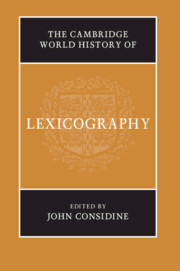Book contents
- The Cambridge World History of Lexicography
- The Cambridge World History of Lexicography
- Copyright page
- Contents
- Contributors
- Editor’s Acknowledgements
- Introduction
- Part I The Ancient World
- Part II The Pre-Modern World
- 6 China, c. 600–c. 1700
- 7 India and Tibet, c. 500–c. 1750
- 8 Arabic to c. 1800
- 9 Hebrew to c. 1650
- 10 The Chinese Periphery to c. 1800
- 11 The Turkic Languages and Persian to c. 1700
- 12 Byzantine Greek
- 13 Medieval Latin Christendom
- 14 Early Modern Western and Central Europe
- Part III The Modern World: Continuing Traditions
- Part IV The Modern World: Missionary and Subsequent Traditions
- Appendix 1 The Language Varieties
- Appendix 2 The Lexicographers
- Primary Sources
- Secondary Sources
- Index
6 - China, c. 600–c. 1700
from Part II - The Pre-Modern World
Published online by Cambridge University Press: 01 September 2019
- The Cambridge World History of Lexicography
- The Cambridge World History of Lexicography
- Copyright page
- Contents
- Contributors
- Editor’s Acknowledgements
- Introduction
- Part I The Ancient World
- Part II The Pre-Modern World
- 6 China, c. 600–c. 1700
- 7 India and Tibet, c. 500–c. 1750
- 8 Arabic to c. 1800
- 9 Hebrew to c. 1650
- 10 The Chinese Periphery to c. 1800
- 11 The Turkic Languages and Persian to c. 1700
- 12 Byzantine Greek
- 13 Medieval Latin Christendom
- 14 Early Modern Western and Central Europe
- Part III The Modern World: Continuing Traditions
- Part IV The Modern World: Missionary and Subsequent Traditions
- Appendix 1 The Language Varieties
- Appendix 2 The Lexicographers
- Primary Sources
- Secondary Sources
- Index
Summary
The story of Chinese lexicography, and indeed of China itself, from the years 600 to 1700 begins and ends in a period of unification. The short-lived Sui dynasty (605–18) unified the Chinese empire after centuries of division. In the wake of a new imperially sponsored examination system came dictionaries aimed at creating a unified standard for exam usage. By the early eighteenth century, the Manchu Qīng dynasty had eliminated most of the vestiges of rebellion from the previous dynasty and was set on expanding its territory. Part of its imperial project was linguistic, as the new multilingual empire staked its claim as an authority on Chinese, among other languages. During this period of more than a thousand years, states and dynasties came and went, and the territory claimed as China fluctuated drastically. A cultural identity, however, came to be maintained, in large part on the basis of a textual tradition. The centrality of texts and language for participating in this culture is reflected in turn by the important place lexicography occupied in the world of Chinese scholarship.
- Type
- Chapter
- Information
- The Cambridge World History of Lexicography , pp. 109 - 129Publisher: Cambridge University PressPrint publication year: 2019
- 2
- Cited by

